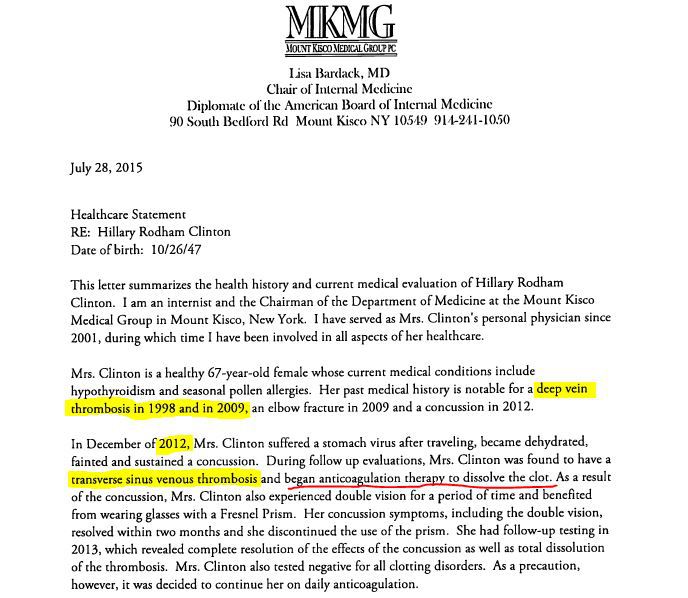
TheTopic is Deep Vein Thrombosis (DVT) and Venous Thromboembolisms (VTE) as it relates to Hillary Clinton's health. You may have heard stories of people getting off airplanes and throwing a clot in their leg and dying. As rare as that is, it is true.
Hillary Clinton has had 2 DVT occurences and 1 VTE in the last 13 years. And her recently disclosed emails gave some info on her continued medication against future episodes.- One of us has nurse training with a focus on disease Pathology .The info reproduced here is from our perpective accurate and educational.
Also. DVT and VTE do not cause paralysis in legs. But they are often a side affect of paralysis due to the lack of movement and circulation. However, DVT can be very painful, and combined with other medical ailments, a person in distress can voluntarily be unresponsive in their lower extremities to avoid the pain. The baggage and fear a potential embolism event can bring is in some people a high anxiety cause. Note that below. Also review the video of Hillary fainting HERE and note her non responsiveness in the legs. Finally if all the attention to her health is too much, then she can easily clear it up and stop the speculation and conspiracy theories by being honest. But we will put Mrs. Clinton on the couch tomorrow. SK
Blood clot facts relevant to the 2016 Presidential campaign
Hillary Clinton's email release this year shows her being reminded to use an injectible anticoagulant Lovenox.

Taking an anticoagulant during higher clot risk situations (like long-distance travel) as a prophylaxis is not unusual for persons with a previous VTE history.
Author Beth Waldron
There is one issue which has not yet received much scrutiny during the primary season which is sure to gain focus during the general election–the physical fitness of each candidate. If elected, Trump would become our oldest President while Clinton would become the first Commander-in-Chief on long-term anticoagulation to prevent the recurrence of venous blood clots. While there was a time when the health of a candidate was considered too personal to broach, in this election season where the most personal of attacks are the norm, pre-existing conditions will certainly be on the table for discussion.
Relevant Facts From the Analysis
- Clinton has the largest elephant in the room with three documented clotting events—in 1998, 2009 and 2012; according to the statement of health issued by her personal physician.(REF 1)
- Once you have a VTE, you are at increased risk for another. Repeat clotting episodes are not unusual—nearly half of VTE survivors will experience another clot within ten years.(5) Clinton’s history of 3 clots within 13 years exemplifies this increased threat rather well.
- High levels of anxiety, depression and psychological stress have been reported among patients with VTE.(3) Numerous studies have found that the psychological consequences of experiencing VTE are considerable
Inaccuracy of medical statement
In the letter here, Dr. Lisa Bardack says: “Mrs. Clinton was found to have a transverse sinus venous thrombosis and began anticoagulation therapy to dissolve the clot.“ That is not correct. Anticoagulants are preventative as Beth Waldron notes.

They are blood thinners in the common parlance. They cannot break clots. Clots are watched for natural break down or are surgically removed. Perhaps the term Anticoagulant was theerror, as drugsdo exist for breaking up clots. But they cannot target just the clot. They also increase the chance of brain bleeds. either the clot dissolves or is surgically removed usually. So my question is,
Why was this not corrected? What are we not being told?
Clinton is not the first politician with a VTE history–Richard Nixon (1965 & 1974) and Dick Cheney (2007) are two with a DVT history that immediately come to mind, Dan Quayle had a pulmonary embolism (1994) and Teddy Roosevelt died of a pulmonary embolism (1919). Nor would Clinton be the first anticoagulated President–Eisenhower was treated with warfarin in1955 following a heart attack (arterial clot) andGeorge HW Bush was placed on warfarinto manage atrial fibrillation in 1991 (to prevent stroke/arterial clot).
Full article HERE
Source CDC.gov
Here is some information culled from the CDC on DVT Emphasis ours
Deep Vein Thrombosis and Pulmonary Embolism (DVT/PE) are often underdiagnosed and serious, but preventable medical conditions.
Deep vein thrombosis (DVT) is a medical condition that occurs when a blood clot forms in a deep vein. These clots usually develop in the lower leg, thigh, or pelvis, but they can also occur in the arm.
It is important to know about DVT because it can happen to anybody and can cause serious illness, disability, and in some cases, death. The good news is that DVT is preventable and treatable if discovered early.
Complications of DVT
The most serious complication of DVT happens when a part of the clot breaks off and travels through the bloodstream to the lungs, causing a blockage called pulmonary embolism (PE). If the clot is small, and with appropriate treatment, people can recover from PE. However, there could be some damage to the lungs. If the clot is large, it can stop blood from reaching the lungs and is fatal.
In addition, nearly one-third of people who have a DVT will have long-term complications caused by the damage the clot does to the valves in the vein called post-thrombotic syndrome (PTS). People with PTS have symptoms such as swelling, pain, discoloration, and in severe cases, scaling or ulcers in the affected part of the body. In some cases, the symptoms can be so severe that a person becomes disabled.
For some people, DVT and PE can become a chronic illness; about 30% of people who have had a DVT or PE are at risk for another episode.
Risk Factors for DVT
Almost anyone can have a DVT. However, certain factors can increase the chance of having this condition. The chance increases even more for someone who has more than one of these factors at the same time.

Following is a list of factors that increase the risk of developing DVT:
- Slow blood flow, often caused by:
- Confinement to bed(e.g., due to a medical condition or after surgery);
- Limited movement (e.g., a cast on a leg to help heal an injured bone);
- Sitting for a long time, especially with crossed legs; or
- Paralysis.
- Increased estrogen, often caused by:
- Birth control pills
- Hormone replacement therapy, sometimes used after menopause
- Pregnancy, for up to 6 weeks after giving birth
- Certain chronic medical illnesses, such as:
- Heart disease
- Lung disease
- Cancer and its treatment
- Inflammatory bowel disease (Crohn’s disease or ulcerative colitis)
Read more by Soren K.Group







